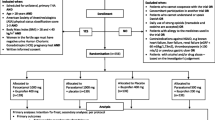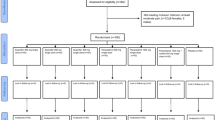Abstract
Background
Ibuprofen and paracetamol (acetaminophen) are very commonly used for analgesia and pain. In 2020, the US FDA gave its first approval of a fixed-dose combination (FDC) of the two drugs in the same tablet for postoperative pain. There has been no quantitative, summative analysis of the FDC effect size measures against postoperative pain in adults. Similar analyses exist, but only in pediatric patients.
Objective
This was the first meta-analysis to compare the efficacy and safety outcomes of the ibuprofen/paracetamol FDC against placebo, administered postoperatively, for moderate to severe pain relief in adults.
Methods
The MEDLINE, EMBASE, and Cochrane CENTRAL databases, in addition to the grey literature, were searched for clinical trials until April 2020, to identify comparative literature studies of the ibuprofen/paracetamol FDC in acute postoperative pain in adults. No restrictions on doses, formulations (oral, intravenous), and underlying type of surgery were applied. Independent reviewers performed the study selection, data extraction, and the risk-of-bias and quality-of-evidence assessments based on the Cochrane criteria. The outcome measures of interest in the meta-analysis were ≥ 50% pain relief , need for rescue medications, and occurrence of adverse drug events. Statistical analyses using a random-effects model were performed, at a statistical significance of p < 0.05. The RevMan software was used for analysis. A trial sequential analysis (TSA) was conducted to assess how precise and conclusive the meta-analysis outcomes are.
Results
Seven double-blind, randomized controlled trials with 2947 participants were included. The FDC dose was at three different levels: 75–100 mg ibuprofen/250 mg paracetamol, 150–200 mg ibuprofen/500 mg paracetamol (FDA-approved dose level), and 292.5–400 mg ibuprofen/975–1000 mg paracetamol. The ≥ 50% pain relief outcome was more achieved with the FDC compared to placebo (risk ratio [RR] 2.60, 95% confidence interval [CI] 2.11–3.20, p < 0.00001), as was the reduced need for rescue medications (RR 0.51, 95% CI 0.37–0.71, p < 0.0001). While inconclusive based on TSA, the FDC was at the highest doses at least as well tolerated as placebo regarding the occurrence of adverse events, including severe, common, and treatment-related adverse events, as well as those that lead to discontinuation, but it was also significantly associated with lower rates of headache and nausea. Subgroup analyses confirmed that the efficacy and safety of the FDC were maintained regardless of doses and formulations. The sensitivity analysis confirmed outcomes against potential publication bias and identified sources of heterogeneity in analyses.
Conclusion
The ibuprofen plus paracetamol FDC is conclusively an effective analgesic against placebo in acute postoperative, moderate to severe pain in adults. It is also superiorly well tolerated, including at the higher dose of 292.5–400 mg ibuprofen/975–1000 mg paracetamol; however, safety outcomes were inconclusive. Future studies need to confirm the safety of FDC and its benefits against other marketed analgesics in postoperative pain.







Similar content being viewed by others
References
Garimella V, Cellini C. Postoperative pain control. Clin Colon Rectal Surg. 2013;26(3):191–6.
Wu CL, Raja SN. Treatment of acute postoperative pain. Lancet. 2011;377(9784):2215–25.
Wang E, Yee C, Tam S, et al. Prevalence of pain in patients with breast cancer post-treatment: a systematic review. Breast. 2018;42:113–27.
Moore PA, Hersh EV. Combining ibuprofen and acetaminophen for acute pain management after third-molar extractions: translating clinical research to dental practice. J Am Dent Assoc. 2013;144(8):898–908.
American Society of Anesthesiologists Task Force on Acute Pain Management. Practice guidelines for acute pain management in the perioperative setting: an updated report by the American Society of Anesthesiologists Task Force on Acute Pain Management. Anesthesiology. 2012;116:248–73.
Fletcher D, Aubrun F. Long texts for the formalized recommendation of experts on management of postoperative pain [in French]. Ann Francaises d’anesthesie et de Reanim. 2009;28(1):1–2.
Moore RA, Derry S, Aldington D, et al. Single dose oral analgesics for acute postoperative pain in adults-an overview of Cochrane reviews. Cochrane Database Syst Rev. 2015;9:CD008659.
Lynagh T, Romero-Rojo JL, Lund C, Pless SA. Molecular basis for allosteric inhibition of acid-sensing ion channel 1a by ibuprofen. J Med Chem. 2017;60(19):8192–200.
Hodkinson DJ, Khawaja N, O’Daly O, Thacker MA, Zelaya FO, Wooldridge CL, Renton TF, Williams SCR, Howard MA. Cerebral analgesic response to nonsteroidal anti-inflammatory drug ibuprofen. Pain. 2015;156(7):1301–10.
Klinger-Gratz PP, Ralvenius WT, Neumann E, et al. Acetaminophen relieves inflammatory pain through CB1 cannabinoid receptors in the rostral ventromedial medulla. J Neurosci. 2018;38(2):322–34.
Moore RA, Moore N. Paracetamol and pain: the kiloton problem. Eur J Hosp Pharm. 2016;23(4):187–8.
Moore RA, Derry S, Wiffen PJ, Straube S, Aldington DJ. Overview review: comparative efficacy of oral ibuprofen and paracetamol (acetaminophen) across acute and chronic pain conditions. Eur J Pain. 2015;19(9):1213–23.
Pierce CA, Voss B. Efficacy and safety of ibuprofen and acetaminophen in children and adults: a meta-analysis and qualitative review. Ann Pharmacother. 2010;44(3):489–506.
Roberts E, Nunes VD, Suckner B, et al. Paracetamol: not as safe as we thought? A systematic literature review of observational studies. Ann Rheum Dis. 2016;75(3):552–9.
Ong CKS, Seymour RA, Lirk P, Merry AF. Combining paracetamol (acetaminophen) with nonsteroidal antiinflammatory drugs: a qualitative systematic review of analgesic efficacy for acute postoperative pain. Anesth Analg. 2010;110(4):1170–9.
Hyllested M, Jones S, Pedersen JL, Kehlet H. Comparative effect of paracetamol, NSAIDs or their combination in postoperative pain management: a qualitative review. Br J Anaesth. 2002;88(2):199–214.
Moore PA, Ziegler KM, Lipman RD, Aminoshariae A, Carrasco-Labra A, Mariotti A. Benefits and harms associated with analgesic medications used in the management of acute dental pain: an overview of systematic reviews. J Am Dent Assoc. 2018;149(4):256–265.e3.
US FDA. Drug Approval Package: Advil dual action with acetaminophen. https://www.accessdata.fda.gov/drugsatfda_docs/nda/2020/211733Orig1s000TOC.cfm. Accessed 31 Mar 2020.
Moher D, Liberati A, Tetzlaff J, Altman DG. Preferred reporting items for systematic reviews and meta-analyses: the PRISMA statement. Ann Intern Med. 2009;151(4):264–9.
Delgado DA, Lambert BS, Boutris N, et al. Validation of digital visual analog scale pain scoring with a traditional paper-based visual analog scale in adults. J Am Acad Orthop Surg Glob Res Rev. 2018;2(3):e088.
Higgins JP, Altman DG, Gøtzsche PC, et al. The Cochrane Collaboration’s tool for assessing risk of bias in randomised trials. BMJ. 2011;343:d5928.
Higgins JP, Thompson SG, Deeks JJ, Altman DG. Measuring inconsistency in meta-analyses. BMJ. 2003;327(7414):557–60.
Higgins JP, Thomas J, Chandler J, et al. Cochrane handbook for systematic reviews of interventions. Chichester: Wiley; 2019.
Efthimiou O. Practical guide to the meta-analysis of rare events. Evid Based Ment Health. 2018;21:72–6.
Deeks JJ, Higgins JP, Altman DG et al. Chapter 10: analysing data and undertaking meta-analyses. Cochrane Handbook for Systematic Reviews of Interventions. Version 6.1, 2020. https://training.cochrane.org/handbook/current/chapter-10#_Ref521576299. Accessed 24 Oct 2020.
Sterne JA, Gavaghan D, Egger M. Publication and related bias in meta-analysis: power of statistical tests and prevalence in the literature. J Clin Epidemiol. 2000;53(11):1119–29.
Terrin N, Schmid CH, Lau J, Olkin I. Adjusting for publication bias in the presence of heterogeneity. Stat Med. 2003;22(13):2113–26.
Brignardello-Petersen R, Bonner A, Alexander PE, et al. Advances in the GRADE approach to rate the certainty in estimates from a network meta-analysis. J Clin Epidemiol. 2018;93:36–44.
Mehlisch S, Daniels SE, Southerden KA, Christensen KS. A single-tablet fixed-dose combination of racemic ibuprofen/paracetamol in the management of moderate to severe postoperative dental pain in adult and adolescent patients: a multicenter, two-stage, randomized, double-blind, parallel-group, placebo-controlled, factorial study. Clin Ther. 2010;32(6):1033–49.
Daniels SE, Atkinson HCI, Stanescu I, et al. Analgesic efficacy of an acetaminophen/ibuprofen fixed-dose combination in moderate to severe postoperative dental pain: a randomized, double-blind, parallel-group, placebo-controlled trial. Clin Ther. 2018;40(10):1765–1776.e5.
Atkinson J, Moodie J, Carson S, et al. Combination paracetamol and ibuprofen for pain relief after oral surgery: a dose ranging study. Eur J Clin Pharmacol. 2015;71(5):579–87.
Pfizer. A safety and efficacy study of ibuprofen 250 mg/acetaminophen 500 mg in the treatment of post-surgical dental pain. 2016. ClinicalTrials.gov. https://clinicaltrials.gov/ct2/show/NCT02912650. Accessed 1 May 2020
Pfizer. A study of ibuprofen (IBU) 250 mg/APAP 500 mg in the treatment of post-surgical dental pain. ClinicalTrials.gov. 2016. https://clinicaltrials.gov/ct2/show/NCT02837952. Accessed 1 May 2020
Daniels SE, Goulder MA, Aspley S, Reader S. A randomised, five-parallel-group, placebo-controlled trial comparing the efficacy and tolerability of analgesic combinations including a novel single-tablet combination of ibuprofen/paracetamol for postoperative dental pain. Pain. 2011;152(3):632–42.
Daniels R, Stanescu I, Zhang J, Gottlieb I, Atkinson HC. Efficacy and safety of an intravenous acetaminophen/ibuprofen fixed-dose combination after bunionectomy: a randomized, double-blind, factorial, placebo-controlled trial. Clin Ther. 2019;41(10):1982–1995.e8.
Bailey E, Worthington HV, van Wijk A, Yates JM, Coulthard P, Afzal Z. Ibuprofen and/or paracetamol (acetaminophen) for pain relief after surgical removal of lower wisdom teeth. Cochrane Database Syst Rev. 2013;12:CD004624.
Ohashi N, Uta D, Sasaki M, Ohashi M, Kamiya Y, Kohno T. Acetaminophen metabolite N-acylphenolamine induces analgesia via transient receptor potential vanilloid 1 receptors expressed on the primary afferent terminals of c-fibers in the spinal dorsal horn. Anesthesiology. 2017;127(2):355–71.
Simpson M, Drum M, Nusstein J, Reader A, Beck M. Effect of combination of preoperative ibuprofen/acetaminophen on the success of the inferior alveolar nerve block in patients with symptomatic irreversible pulpitis. J Endod. 2011;37(5):593–7.
Aitken I, Playne R, Zhang J, Frampton CMA, Atkinson HC. An integrated safety analysis of combined acetaminophen and ibuprofen (Maxigesic/Combogesic) in adults. J Pain Res. 2019;12:621–34.
Southey ER, Soares-Weiser K, Kleijnen J. Systematic review and meta-analysis of the clinical safety and tolerability of ibuprofen compared with paracetamol in paediatric pain and fever. Curr Med Res Opin. 2009;25(9):2207–22.
Robertson J. Review: no evidence exists that paracetamol and ibuprofen differ for short term pain relief or safety in children, but ibuprofen more effectively reduces fever. Evid Based Nurs. 2005;8(1):10.
Gupta U, Verma M. Placebo in clinical trials. Perspect Clin Res. 2013;4(1):49–52.
Colloca L. The placebo effect in pain therapies. Annu Rev Pharmacol Toxicol. 2019;59:191–211.
Tarabar S, Kelsh D, Vince R, et al. Phase I pharmacokinetic study of fixed-dose combinations of ibuprofen and acetaminophen in healthy adult and adolescent populations. Drugs R D. 2020;20(1):23–37.
Uptodate. https://www.uptodate.com/contents/search. Accessed 15 Jun 2020.
Theken KN, Lee CR, Gong L, et al. Clinical Pharmacogenetics Implementation Consortium (CPIC) guideline for CYP2C9 and nonsteroidal anti-inflammatory drugs. Clin Pharmacol Ther. 2020;108(2):191–200. https://doi.org/10.1002/cpt.1830.
Krasniak AE, Knipp GT, Svensson CK, Liu W. Pharmacogenomics of acetaminophen in pediatric populations: a moving target. Front Genet. 2014;5:314. https://doi.org/10.3389/fgene.2014.00314.
Merry A, Gibbs R, Edwards J, et al. Combined acetaminophen and ibuprofen for pain relief after oral surgery in adults: a randomized controlled trial. Br J Anaesth. 2010;104(1):80–8.
Acknowledgements
The authors would like to acknowledge Ms. Nurhan Alshafey, PharmD, Research Assistant, Hamad Medical Corporation, Qatar, for her role as a second reviewer for study selection and data extraction in this project.
Author information
Authors and Affiliations
Corresponding author
Ethics declarations
Funding
The authors acknowledge the funds provided by Qatar University, Qatar, through internal grant number QUST-1-CPH-2020-1.
Conflict of interest
Dina Abushanab and Daoud Al-Badriyeh have no disclosures to declare with regard to the authorship and/or publication of this manuscript.
Ethics approval
This was an analysis of literature data, therefore no ethics approval is required.
Author contributions
D. Al-Badriyeh conceived and designed the study and the statistical methods. Both authors contributed to the data collection and analysis, interpretation of results, and writing of the manuscript, and both authors read and approved the final version of the manuscript.
Availability of data and material
Available from the corresponding author upon reasonable request.
Electronic supplementary material
Below is the link to the electronic supplementary material.
Rights and permissions
About this article
Cite this article
Abushanab, D., Al-Badriyeh, D. Efficacy and Safety of Ibuprofen Plus Paracetamol in a Fixed-Dose Combination for Acute Postoperative Pain in Adults: Meta-Analysis and a Trial Sequential Analysis. CNS Drugs 35, 105–120 (2021). https://doi.org/10.1007/s40263-020-00777-7
Accepted:
Published:
Issue Date:
DOI: https://doi.org/10.1007/s40263-020-00777-7




